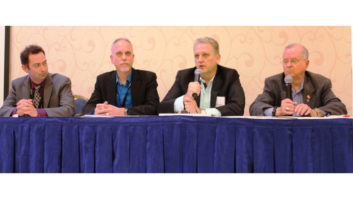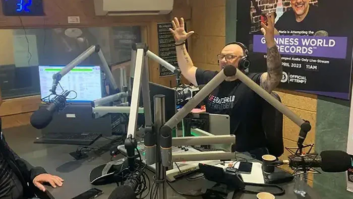When KUVO(FM) in Denver aired a Colorado Symphony Orchestra concert with Dianne Reeves on Sept. 24, it did so in both stereo and 5.1 surround sound.
Few, if any, listeners could hear the five channels. But this is believed to be the first live concert broadcast in 5.1 surround via HD Radio.
The station also will take part in the first national surround broadcast next month on NPR, a big event with programming from multiple venues, including one in Paris.
But this is not the first time KUVO has given thought to 5.1.
“We record every major live remote we do in 5.1,” Chief Engineer Mike Pappas told me. Why? Because management at “jazz89” expects that, at some point, the programming will be needed.
Pappas said radio enjoys the perfect environment for surround: the car, a “fixed listening environment, closed, with no ‘wife acceptance factor,'” he said. Fans of new technology, often male, don’t have to talk their spouses into home surround systems.
“We have dozens of recordings that we’ve done in 5.1 over four or five years, and figured it was time we had a method to transmit that technology to our listeners. We’ve been building that library because we know that at some point we’re going to need these broadcasts.
“We in the radio business have to come up with new innovations to keep people from going someplace else,” he said. “That involves programming too; but technically it’s up to us to try new things and push the envelope. The first guys who broadcast color knew there weren’t any receivers out there, but they knew it would be important to the growth of the medium.”
KUVO also was Colorado’s first public station to convert to HD Radio.
Watermarked
I enjoy – I love – talking to people who innovate. How refreshing to hear an articulate technical leader brag that his bosses want to invest in radio.
(When I hear this kind of talk, it’s usually at public stations. Not always, but often. Don’t believe it? I have two words: Tomorrow Radio.)
I remember that several years ago, Leslie Stimson and I were discussing an article about surround and whether the technology might work on radio. At the time it seemed a stretch. But as we reported then and have since, forward-thinking types said that if surround worked, it could be the “killer app” people talk about for radio and IBOC.
“I’m hoping the 5.1 thing catches on because we need it,” Pappas said. “We need HD Radio, we need the digital service, we need surround for radio. Look at the number of people who own home theaters – now you can buy a $500 system.”
In Europe, experiments with 5.1 surround broadcasts also are ongoing. The 2003 and 2004 Prix Europa media festivals featured live 5.1 surround broadcasts of the festival’s opening concert that were distributed to public broadcasters across the continent via satellite.
But is a surround experience something of interest only to high-end public jazz stations?
“Look at what happened with digital,” Pappas replied. “CPB said, ‘Let’s take a bunch of money to get public stations going.’ The commercial guys stood back and watched. Suddenly you have a hundred or so public stations on the air or getting ready. Then the commercial guys said, ‘Holy cow, we have to get this going.’
“I think public radio will do the work, work the bugs out and then commercial will go after it.”
For the September broadcast, KUVO used equipment on loan from suppliers: a Harris/Neural NeuStar audio processor and two Neural Audio’s 5225 Mix-Edit Transcoders, which allow the broadcaster to create or edit content that originates as 5.1, mono or stereo, blend discrete and upmixed elements and store the content in 5.1 or 2.0 formats. This is a “watermarked” downmix system that creates a compatible stereo signal. Pappas runs the 5.1 into the 5225, then takes the stereo output and broadcasts that.
“We had two (5225s), so we could back to back them after running it through our router – listen to the 5.1 going in, the stereo feeding the plant and then the 5.1 decode.”
Image stability
Pappas was delighted with the outcome – concerned foremost with the effect on his existing signal.
“We would not have risked the biggest remote KUVO’s ever done if it in any way was going to impair our conventional stereo signal.” He said the 5225 gave “the best surround you can get out of a 96 kilobit stream in any shape. It delivers pristine decoded 5.1; and the watermarked stereo it creates is just amazing.
“You hit it with four AES/EBU inputs – left-right, center-LFE, left surround, right surround. It is running 1.35 billion operations per second,” Pappas said.
“It’s not a matrix. I worked in TV and we did matrixed Dolby for big events. Matrixed systems in music environments have a problem: there’s little image stability. You can’t have violins wafting around the sound field and cellos showing up in the rear channels. This is the only box I’ve ever heard that lets you take 5.1, make stereo out of it, then convert it back to 5.1 and have perfect image stability. Everything is in the spot we put it on the input side.”
He said, “The four inputs give you an AES 44.1/24-bit stereo output, with a 16 kbps watermark that I cannot hear on my $85,000 home hi-fi. You can edit it on ProTools, record it to DAT, MiniDisc, CD-R or even analog tape; you can play it back and, voilà, you’ve got surround. And I don’t need 3 times as many inputs in my plant – which you’d need if you wanted to handle surround as a discrete approach; that’s financially infeasible.”
Experiment
Pappas is sold. But make no mistake; in his eyes this is a technological experiment.
“In fact I didn’t tell anyone we were planning until probably 3 or 4 days before. You don’t want to tell the listeners you’re doing it if they have no provisions to play it back. Second, our underwriter for the event, Ultimate Electronics-SoundTrack, doesn’t have any 5.1 decoders to sell our listeners. …
“It was an experiment to see if we could do it, if it made high-enough-quality conventional stereo, albeit with watermarking, and what the response was from a listening audience that had no preconceived notions.” Pappas said the station received two dozen unsolicited e-mails complimenting the broadcast. Of course, this may also reflect the program content and other factors.
“We pulled out all our stops to make this our best session ever. We requested from Sennheiser Germany that they send their resident Tonmeister because we needed more ears that had done a lot of symphony work. You don’t get an opportunity to record the Colorado Symphony with Dianne Reeves every day.”
Confronting convention
Pappas said you don’t need HD Radio to use this technology; he believes analog stations also would benefit from using the 5225. “Our analog listener can decode the signal and make 5.1. We shipped the exact same stereo watermarked signal to both the analog FM side and the HD Radio side.”
So, what will it take for surround on the radio to work?
“From a delivery standpoint, we’ve proven we can deliver it with the current infrastructure. The problem is promoting it. Until we get magic decoder boxes for the consumer – I foresee that a year from now, we’ll be promoting it. For car listeners. I’m gonna stick my neck out and say decoders will be under $400.”
Pappas is excited to be part of the Dec. 31 nationwide NPR broadcast, for which his station will provide 75 minutes of 5.1 programming. Radio World will tell you more about this in an upcoming issue.
But for now, Pappas knows the “pitch” for surround won’t be easy.
“We do have some selling to do here. If you go to broadcasters, they’ll look at the cost and say ‘no way.’ We’ve gotta come up with a system that allows you to use your existing infrastructure, conventional stereo which is what the 5225 lets us do.
“Broadcasters tend to be a conservative lot. I do this because I have the full faith and support of my PD and president at KUVO. They like to see us on the cutting edge, and they realize that comes with a cost.”












